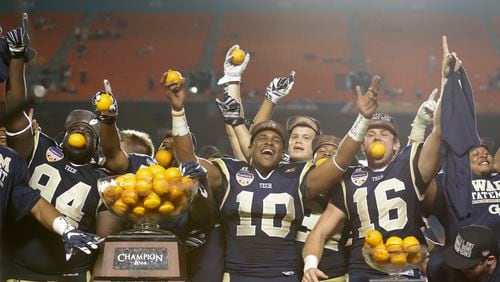Georgia Tech is preparing room in the budget for cost-of-attendance stipends that will be given to scholarship athletes starting in the fall. The NCAA’s “power five” conferences, granted autonomy to pass measures without the support of the remainder of Division I, passed legislation Jan. 17 to supplement scholarships with a stipend to cover cost-of-living expenses.
Tech athletic director Mike Bobinski said that providing stipends for the school's roughly 225 scholarship athletes should cost the athletic department about $500,000. He said he’ll seek donor support to help fit it into the budget. Tech’s projected expenses for the current fiscal year are $76.7 million.
“While it’s challenging to deal with an additional expense, it’s something we’re going to do our very best to make happen,” he said. “We’ll work it out one way or another.”
Cost-of-attendance totals are determined by each school according to federally created guidelines and can have significant variance. Tech’s is about $1,600, Bobinski said at a meeting of the athletic association board Thursday. Other schools range from $1,200 to as much as $5,500. Kennesaw State’s is $2,875 for in-state students. Emory’s is $2,364. Georgia’s is $2,598. Tennessee’s, Bobinski said, is $5,500. The totals are calculated by schools for the purpose of determining financial aid, and not by athletic departments. (Athletes on partial scholarships will receive a stipend proportional to their scholarship amount.)
Bobinski acknowledged the likelihood that the differing stipend amounts will become a factor in recruiting. He said that the athletic department will have to work to develop an apples-to-apples comparison to present to prospects who are comparison shopping. For instance, Tech athletes are provided a laptop computer. Other schools’ cost figures may include the cost of a computer.
As for the concept of cost-of-attendance stipends, Bobinski called it “the appropriate outcome.” Along with every power conference school but one (Boston College), Tech voted for the stipend to cover the cost of attendance.
Other notes from the board meeting:
1. School president G.P. "Bud" Peterson said that, after the school surpassed its $1.5 billion goal for its capital campaign in October, school officials decided against raising the goal again, but is trying to meet specific goals within the overall campaign, such as endowing 100 professor chairs.
Over the course of several years, the athletic department met its initial goal of raising $200 million, then met increased goals of $225 million and $250 million.
2. The athletic department is on track to finish the fiscal year with a $1.8 million surplus over projections. It's largely due to the unbudgeted $2.6 million payment the school received as part of Maryland's settlement with the ACC. The surplus will go into the GTAA fund, which essentially serves as a savings fund to cover years when the budget runs at a deficit.
3. Football ticket revenue finished at about $7.7 million, which narrowly exceeded budgeted revenue, thanks to strong individual game sales for the Georgia Southern, Miami and Virginia games. Men's basketball season-ticket sales fell about $300,000 short of the goal of $1.3 million. The department is expecting to exceed project revenues of sales from individual games and mini-packs.
4. Tech's participation in the ACC championship and Orange Bowl were projected to cost the department about $525,000 due to shortfalls in mandatory ticket sales and coaching bonuses. (The game being played on New Year's Eve and a very soft re-sale market contributed to slow sales.)
“That’s an issue we’ve talked about with the Orange Bowl about,” Bobinski said of the secondary-market sales undercutting the schools’ ticket sales. “You can’t do that to your teams because it puts us in a box.”
That said, he called the loss “an investment I think well worth the return” given the publicity and good feeling that both games brought the school. The Orange Bowl, for instance, was ESPN's highest-rated New Year's Eve game on record, averaging 8.9 million viewers. There were obviously internal benefits, as well.
“I know Coach (Paul) Johnson has talked to our guys a lot about, this has been a tremendous accomplishment, we couldn’t be more proud of what we’ve done,” Bobinski said. “The key now is to have that as our launching point, not our destination. This is where we work from now.”
5. The renovation of the space underneath the Russ Chandler Stadium stands is nearly completed. The entire space, which includes locker room areas, hitting bays, weight and training rooms, has been overhauled.
“It’s a tremendous improvement over what it was,” Bobinski said.
Bobinski is also planning to have work done at the Edge Center, Tech’s athletic offices, particularly the training and academic support areas.
“We want to make sure we put this place together for the way it works for the Georgia Tech athletes of the future,” he said.
Bobinski said he had already received an anonymous $3 million challenge gift. He said the amount of donations will determine the scope of the project.







